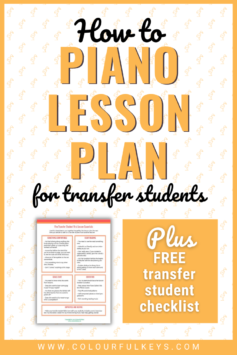
This article about curriculum planning for a transfer piano student was written by Natalie Weber, NCTM. Natalie has operated a private music studio in Derby, Kansas, USA since 1998, where she teaches a wide range of ages in private lessons and group classes. She also runs the popular Music Matters Blog, and is devoted to inspiring creativity in music education.
Transfer students often come through our piano studio doors without a guidebook. How do you plan an effective curriculum when you don’t know their gaps, what they like to play and their strengths and weaknesses?

Transfer students come in as many varieties as there are butchered versions of Für Elise on YouTube. In fact, you may recognise a transfer student by their attempt to play such a classic for you at their initial lesson – all while struggling to identify notes on the staff or count basic rhythms.
But don’t dismay! Here are 5 steps you can follow to plan an effective curriculum for a transfer piano student.
Step 1: Conduct an Interview and Evaluation
This is something I do with every prospective student, but it is imperative with transfer students. I ask them to bring whatever materials they’ve used before, and prepare to play 2 pieces for me.
This allows me to make notes related to their playing:
- Did they maintain continuity?
- How was their note accuracy? Rhythmic accuracy?
- Did they incorporate any stylistic elements?
Once they’ve played, we look over the piece together and I ask them questions about everything on the page – clefs, note names, intervals, chords, symbols, etc. I let them know that it’s no big deal at all if they don’t know something. The more open and honest they are about what they do and don’t know so far, the better I’ll be able to put together the best plan for them to succeed.
Psst…If you’ve never had a meeting with a potential transfer student, this article is a must-read: 6 Illuminating Questions to Ask a Transfer Piano Student.
Find Out What Makes Your Transfer Student Tick
In addition to gauging the student’s musical knowledge, I’m getting a feel for their personality, learning style and overall musical aptitude.
At the same time, I have the parent completing a questionnaire giving me additional information to use when I begin specific lesson planning. All of this is essential for the next step.
Step 2: Communicate a Vision
Paint a picture of what your piano student will be able to do on piano this time next year. This serves two key purposes:
- Your student will be excited to continue lessons with you and your studio.
- By visualising a path, you’ll start to outline a basic curriculum for your transfer student.
At the End of Your Student Interview
Begin by noting the areas where the student is doing well and where you see particular potential. Then, identify areas you see as opportunities.
This paves the way for the most important feedback, which is an explanation of the vision you have for the student and how you hope to see them achieve it.

This is something I address to the student, but I include the parent while I’m speaking because it’s important for all of us to be on the same page and for them both to leave the interview excited about the possibilities ahead.
Step 3: Cover the Basics
Now that you have an idea of where you’re starting and everyone is excited to move forward, it’s time to put a plan in place.
The curriculum you design now isn’t meant to be a rigid calendar; it’s a flexible framework which gives you a path forward to ensure you don’t miss anything critical.
Typical Transfer Student Trouble Spots
Never make assumptions about what a student already knows. I often find myself saying to transfer students, “You might have heard some of this before, but let’s go over it just to make sure we don’t miss anything important.”
For this reason, I think every transfer piano student curriculum should include review of:
- Notes on the staff
- Rhythm reading
- Aural work (Can they echo 1-bar rhythms?)
- Scales and technical work
- Creative skills such as improvisation and composition
- Keyboard geography
If you’re not sure where your transfer piano student’s gaps are, check out Nicola’s 7 Awesome Tools to Assess and Address Transfer Piano Student Gaps.
It’s amazing how impactful it is for a student to achieve success in these basic areas. They give students a greater level of confidence and lay a foundation that will set them up for success as they continue to explore the many possibilities that the world of music has to offer.

Subscribe to updates and get the transfer student checklist.
Enter your details to subscribe to the newsletter for piano teachers with information, tips and offers.
I hate spam as much as you do! I’ll only send you information that’s directly relevant to music teachers and you can unsubscribe at any time.
Pssst: VMT members can download the checklist from the printable library. Not a member yet? What are you waiting for?! Check out the membership at vibrantmusicteaching.com.
Step 4: Customise the Plan
With this framework in place, you now have the freedom to begin customising additional elements specific to each student’s goals and interests.
One of my priorities for each student is to help them sound good at the piano. I want them to learn to play the music that they are eager to play for others.
This often means incorporating rote teaching into the curriculum. Because, let’s face it, most older students aren’t going to be recruiting friends and family to come to listen to them play Ode to Joy at the next studio recital. But the pop-sounding rote piece The Piano Guy by Samantha Coates? Yes, please!
Coates’ Rote Repertoire pieces have been the perfect approach for many of my transfer students. I can find them a piece that fits their preferred style, then use her 3-level approach to teach it to them systematically at each lesson, resulting in an impressive musical selection that any student can be proud to play for their peers.
If you’re a member of Vibrant Music Teaching, remember to use the membership link for a special VMT discount on BlitzBooks Rote Repertoire.
I’ve also begun compiling a notebook of pieces that are conducive to rote teaching so I can turn to it for ideas when I’m working with a particular student.
Step 5: Cultivate Technique
This fifth and final tip for planning an effective curriculum for your transfer students may seem unexpected: Technique.
When I was a new teacher, the concept of proper technique wasn’t even on my radar.
But over the years, under the excellent guidance of my own teacher and with the instruction of various individuals who have devoted their careers to understanding the human body and how to use it properly to play the piano beautifully, I’ve grown to appreciate the immeasurable value of healthy technique for every piano student.

Principles like gravity, strength, and conduction undergird teaching of proper piano technique.
Sometimes it takes students weeks or months to learn how to release their arm weight so that gravity helps them create a rich tone and a fluid motion when they are playing.
I love watching the faces of my students light up when they hear themselves creating a rich musical sound or playing with ease a passage that used to cause frustration. One transfer student who learnt to use her arm weight to move across the keys exclaimed, “Now I feel like I’m really playing!”
Even simple broken chord cross-overs, accompanied by the damper pedal, when played with beautiful movements of the arm and an emphasis on musical artistry, can propel students to experience the “wow” factor when playing.
Becoming Transfer-Student Ready
I’ve heard many teachers bemoan the task of addressing the deficiencies of transfer students, but my own teacher’s attitude was one of acceptance. She accepted me where I was and then poured her heart into helping me grow as a musician and pianist. I am forever grateful for her investment in my life.
Armed with inspiration from her and these 5 tips to help me plan an effective curriculum, the message I want my studio to convey is this: Transfer piano students are welcome here!

What tips do you have for welcoming and teaching transfer students in your studio?
Did I miss anything in my transfer piano student curriculum? Share your ideas in the comments below.
Nicola and the gang have a fantastic hub page for planning lessons, where you’ll find loads of resources about transfer students and planning your own curriculum. Check it out!